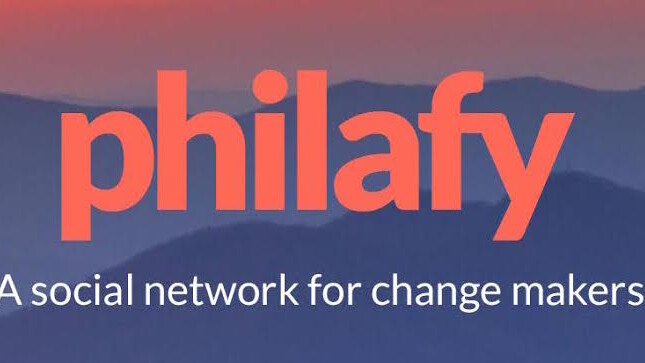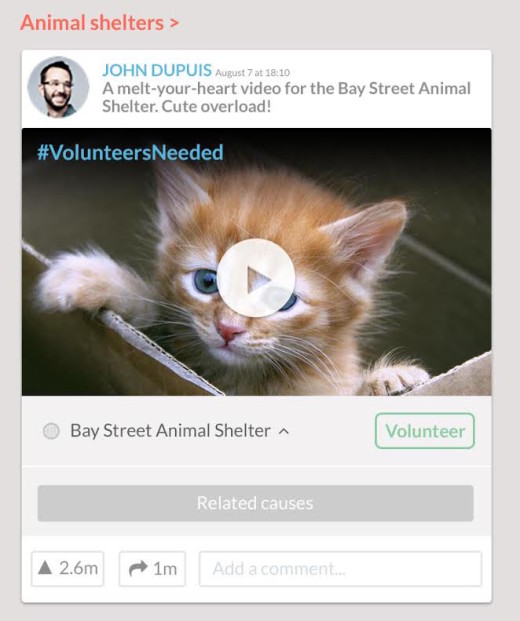
Each week we’re profiling one company that has been selected for Boost – our early-stage startup growth program. Catch up with these companies in person at The Next Web Conference in New York on November 18.
Getting people to turn social connections into social action is one of the great conundrums of the internet. We spend so much time posting statuses, snapping photos, tweeting and sliding into DMs that it’s hard to remember that it can be a place for good.
That’s the mission of Philafy, a Montreal-based budding social network designed to get people to not only think about what matters to them, but help them pledge small donations that will hopefully turn into a bigger impact over time.
TNW spoke with founder Jason Dominique about how the company works, and why he thinks philanthropy matters.
Can you tell me what you do in a couple of sentences?
We’re building a massive new social network of change-makers that will compete with Facebook’s global good segment (Nonprofits, NGOs, Causes). By offering mainstream platform features — starting with payment processing for donations and quickly followed by crowdfunding, petition, events and ticketing — we could solve the varied needs of today’s nonprofits, change-makers and other social businesses.
We’re also developing a one-click ’Give’ button that lets users support friends/nonprofits with micro donations (e.g. 50¢, $1 or more). This native button — think of it as a ‘Buy it’ button for Pinterest Pins, but for giving — can be added to any organic posts and will benefit the nonprofit of their choice on Philafy.

What’s your origin story? I understand there might have been a pivot…
In 2010, I launched a travel company that specialized in overseas fundraising expeditions (e.g Climb Kilimanjaro for a cause) and our clients were mostly smaller nonprofits (>$1M in annual revenues/donations). At that time, online fundraising/crowdfunding was still in its pre-puberty — Kickstarter was still in its first year — and pretty much none of our clients had this technology.
To increase the participants overall experience and their chances of success, I thought we should go ahead and develop our own. Remember that without a fundraising platform, participants had to collect cash/check donations and track every donors on printed excel spreadsheets! My business partner at the time thought that building a fundraising platform wasn’t what he initially got into, so I decided to split. I wanted to dig deeper into this problem.
So in the spring/summer of 2014, short after conducting some initial market research and surveys, I funded the development of an initial MVP. Think of it as an ‘About.me’ for Nonprofits that could also process single and recurring donations. It seemed to be a great idea at first. We were wrong.
The “do one thing really well” approach actually proved to be the problem. The global good space is a fragmented mess that requires nonprofits (and change-makers) to use multiple sites, products and services — this includes management softwares (e.g. Blackbaud, DonorPerfect), fundraising and petition platforms (Classy, Crowdrise, Change.org), events tools (Eventbrite), payment solutions (Paypal, etc.) and social networks (Facebook, etc.) — to acquire, engage, retain and convert supporters.
This makes nonprofits’ lives harder and for most people, this friction of having to visit and register on multiple sites makes it even more difficult for them to give or take action. The reality is that for today’s nonprofit, there’s no good integrated solution.
So we naturally evolved to solve this problem by delivering all the mainstream features they need in one place.
Who do you consider a competitor?
Facebook and Twitter will always be fearsome players at generating awareness (e.g. Arab Spring) in the global good space. Unfortunately, continued high levels of awareness for ongoing important issues (e.g. breast cancer), can result in cause awareness fatigue and “slacktivism.” People are generally aware enough: now they want to take meaningful steps towards action. Their lack of dedicated content/audience and features will always leave room for other players like us.
On the platform end, every day we hear about a new crowdfunding, petition, event and ticketing site which keeps fuelling the fragmentation. The reality is that competing products have plateaued, offering incremental advantages to users and with marginal differences between them. Generosity.com, is a great example. They only way they see themselves getting in the game is by waiving their fee. This is always a bad idea since you’re telling everyone to use your service because it’s free instead of saying that it’s great and that it brings value to users.

What do you do better than them?
Competing products are still focused on servicing outdated donor behaviours (e.g. planned giving) and we believe this is why online giving is still locked at 6.7 percent as of 2014 in the US and isn’t growing with millennials (98 percent of Millennials aren’t satisfied with their online philanthropic involvement).
Individuals cannot continue giving substantial amounts (<$20) and commit multiple open-ended subscriptions to various causes. For this, average individual donation amounts have to be decreased radically to make way for an increased frequency that is based more on impulse, projects, or current events. One more thing, the way causes are currently supported — mailing checks and using a credit card over the phone or on a nonprofit’s website — is not sustainable. Just like e-commerce, giving will increasingly be more social.
Ultimately, Philafy is better in every way because it’s built to let users go from discovery to action without ever leaving the website/app. It’s a much nicer experience than having to go through the whole web flow of 6-7 steps. With Philafy, donors could just hit ‘Give’ to get it done right then and there.
How can we get more people excited about philanthropy?
“The world has so many problem that it feels unfixable”, “Where do I start?,” and “I’m just one person, how can I possibly make a difference?”
By bridging the gap between issues and solutions, Philafy could be the place where everyone goes to answer these questions in an instant and take action in one click. One thing is for sure, we’ve been working on Philafy for the last 2 and half years, and the response from nonprofits and people has been overwhelmingly positive, often emotional. Why? Because Philafy offers hope. Hope that the world’s problems can be truly fixed, not just “liked”.
➤ Philafy
Get the TNW newsletter
Get the most important tech news in your inbox each week.





